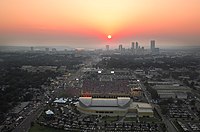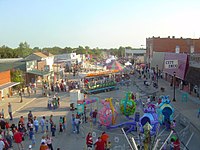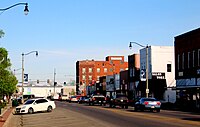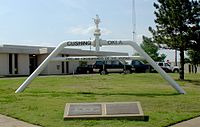Cities 1
Tulsa is the second-largest city in the state of Oklahoma and 45th-largest in the United States. With an estimated population of 382,872 in 2006, it is the principal municipality of the Tulsa Metropolitan Statistical Area, a region of 897,752 residents projected to reach one million between 2010 and 2012. The city serves as the county seat of Tulsa County, the most densely populated county in Oklahoma.
Tulsa was first settled in the 1830s by the Creek Native American tribe. In 1921, it was the site of the infamous Tulsa Race Riot, one of the largest and most destructive acts of racial violence in the history of the United States. For most of the 20th century, the city held the nickname "Oil Capital of the World" and played a major role as one of the most important hubs for the American oil industry. Tulsa has been credited as the birthplace of U.S. Route 66 and the home of Western Swing music. (Read more...)
Cities 2
Oklahoma City is the capital of the U.S. state of Oklahoma. The county seat of Oklahoma County, the city is the 30th largest in the U.S.. The city's estimated population as of 2006 was 537,734, with a 2006 estimated population of 1,172,339 in the metropolitan area. Founded during the Land Run of 1889, Oklahoma City was the site of the bombing of the Alfred P. Murrah Federal Building in 1995, the largest act of terrorism on American soil prior to the September 11, 2001 attacks and the most destructive act of domestic terrorism in American history.
By the time Oklahoma was admitted to the Union in 1907, Oklahoma City had already supplanted Guthrie, the territorial capital, as the population center and commercial hub of the new state. Soon after, the capital was moved from Guthrie to Oklahoma City. Oklahoma City was a major stop on Route 66 during the early part of the 20th century and was prominently mentioned in Bobby Troup's 1946 jazz classic, "(Get Your Kicks on) Route 66," later made famous by Nat King Cole. (Read more...)
Cities 3
Broken Arrow is a city located in the northeastern part of the U.S. state of Oklahoma, primarily in Tulsa County with an extension into western Wagoner County. It is the largest suburb of Tulsa and the 4th largest city in the state. As of the 2006 census estimates, the city had a total population of 88,314 while the city's current estimate puts the population at just over 97,000. It is estimated that at the 2010 census, the population will well exceed 100,000.
The name comes from an old Creek community in Alabama. When they moved to Oklahoma on the Trail of Tears, they started a new community named after the original settlement in Alabama. The town's Creek name was Rekackv (pronounced thlee-Kawtch-kuh), meaning broken arrow. This new settlement was located several miles south of present-day downtown Broken Arrow. In the 1960s, Broken Arrow began to grow from a small town into a suburban city. The Broken Arrow Expressway (Highway 51) was constructed in the mid-1960s and connected the city with downtown Tulsa, fueling growth in Broken Arrow. The population swelled from a little above 11,000 in 1970 to more than 50,000 in 1990, and then more than 74,000 by the year 2000. During this time, the city was more of a bedroom community. In recent years, city leaders have pushed for more economic development to help keep more Broken Arrowans shopping and dining in town rather than going to other cities. (Read more...)
Cities 4
Portal:Oklahoma/Cities/4 Muskogee is located in Muskogee County, Oklahoma and is the county seat of Muskogee County. The population was 38,310 at the 2000 census, making it the eleventh largest city in Oklahoma.
Muskogee first received recognition when in 1805 US President Thomas Jefferson addressed the United States Congress seconding the recommendation of Meriwether Lewis that a trading post be established near the modern day city. French fur traders had already existed in the area for some time before the American acquisition of the Louisiana Purchase. The French were believed to have established a temporary village near Muskogee in 1806, but the first permanent settlement was established in 1817 on the south bank of the Verdigris River, north of Muskogee. (Read more...)
Cities 5
Norman, is the county seat and largest city in Cleveland County, and is part of the Oklahoma City Metropolitan Statistical Area. Norman is situated approximately 20 miles south of downtown Oklahoma City and is the third largest city in the state. As of 2006, the city was estimated to have 102,827 full-time residents. It is the business and employment center of Cleveland County.
Norman is best known as the location of the University of Oklahoma (with about 35,000 full-time students), making it a center of culture, technology, and scientific research. OU is home to the Sam Noble Oklahoma Museum of Natural History, one of the largest of its kind, and the Fred Jones, Jr. Museum of Art.
Norman is a prominent center of meteorological research, specifically severe weather. The National Weather Center, located on OU's Research Campus near State Highway 9 and Jenkins Avenue, houses several NOAA organizations, including the Storm Prediction Center and the National Severe Storms Laboratory, along with the University's weather-related units including the School of Meteorology. Private sector meteorological companies are located alongside the 2006 facility at "Partners Place". (Read more...)
Cities 6
Portal:Oklahoma/Cities/6 Sand Springs is a suburb of Tulsa, Oklahoma and is located predominantly in Tulsa County, with some areas of the city situated in Osage County to the North. The population was 17,451 within the city limits at the 2000 census. Included the unincorporated areas the population is approximately 45,000. The city was founded by Oklahoma philanthropist Charles Page. He envisioned Sand springs as a haven for orphans and widows. He helped found and develop Sand Springs as a model city that included all components of a total community. Today, Sand Springs is ripe with growth and development due to its strategic location near downtown Tulsa and proximity to cultural and recreational opportunities. Numerous private and governmental projects are currently underway to morph Sand Springs from a historically-rich bedroom community into a progressive and complete community. (Read more...)
Cities 7
McAlester located in Pittsburg County, Oklahoma, United States. The population was 17,783 at the 2000 census. It is the county seat of Pittsburg County.
The crossing of the east-west California Road with the north-south Texas Road formed a natural point of settlement in Tobucksy County of the Choctaw Nation, a site originally called Bucklucksy. James Jackson McAlester, an employee of licensed traders Reynolds and Hannaford convinced the firm to locate a general store at that location in late 1869. The general store was an immediate success, but J.J. McAlester recognized an even greater opportunity in the abundance of readily available coal deposits in the area, and the impending construction of a rail line through Indian Territory. In 1871, J.J. McAlester journeyed with a sample of coal to the railroad town in hopes of persuading officials to locate the line near his store at Bucklucksy. The location of the trading post on the Texas Road weighed in its favor, given that the Katy Railroad line construction roughly followed the Shawnee Trail – Texas Road route southward to the Red River. The line reached Bucklucksy in 1872 and Katy Railroad officials named the railway stop McAlester. (Read more...)
Cities 8
Coweta is the largest city in Wagoner County, Oklahoma and is a suburb of Tulsa. The population was 8,352 at the 2005 census.
Before statehood, when the Five Tribes or Five Civilized Tribes were moved to Oklahoma from the Eastern United States, the area that is now Coweta became part of the Creek Nation. Coweta was first settled about 1840, after the Creek War, and named for a Creek (Native American) town on the Chattahoochee River in southwestern Georgia. In 1843 Robert Loughridge arrived in the area and established a mission, named "Koweta". In 1867 after the Civil War, the Creek Indians adopted a constitution which divided their nation into six districts. Everything northeast of the Arkansas River, including Tulsa, became the Coweta district. The political center of this district was located in a log courthouse on Coweta Creek, about a quarter-mile west from the modern-day center of the downtown Coweta. The Post Office was established on May 24, 1897, and took its name from Koweta Mission. (Read more...)
Cities 9
Durant is located in Bryan County, Oklahoma, United States. The population was 15,050 at the July 2006 census. The Durant Micropolitan Area has approximately 39,000 residents, the city also lies in Speairs Township. Durant is the county seat of Bryan County.
Durant was ranked as the fastest growing rural city in Oklahoma in 2004, having the fastest growth rate outside of the Oklahoma City and Tulsa metropolitan areas. Today, the city is ranked as one of the fastest growing cities in the country. Less than ten miles away, Lake Texoma has between 8-10 million tourists every year and is the 12th largest lake in the United States, and also one of the largest reservoirs in the country, contributing to Durant's economic and population growth.
Durant is home to Southeastern Oklahoma State University and also the Headquarters of the Choctaw Nation of Oklahoma, though the historic capital building is in Tuskahoma. Durant ranks as the second largest city within the Choctaw Nation, following McAlester, while Poteau is the third largest city. The city has officially been recognized as the Magnolia Capital of Oklahoma, and the SOSU campus is known as the "Campus of 1,000 Magnolias". (Read more...)
Cities 10
Enid is located and is the county seat of Garfield County, Oklahoma, United States. The population was 47,045 at the 2000 census.
Enid was founded during the opening of the Cherokee Outlet by land run in 1893. Today, the history of this era is preserved at the Museum of the Cherokee Strip, located in Enid. Vance Air Force Base was founded in 1941 on land leased by the city of Enid to the United States Army Air Forces, now the United States Air Force. Enid was once home to Champlin Petroleum; the H. H. Champlin mansion is on the National Register of Historic Places. The town's early history was captured in The Cherokee Strip by Pulitzer-winning author Marquis James, who recounts his boyhood in Enid.
The origin of the name Enid is something of a mystery, although it is considered likely to be a reference to a character in Alfred Lord Tennyson's Idylls of the King. However, a more fanciful story is much more popular. According to that tale, in the days following the land run, some enterprising settlers decided to set up a chuckwagon and cook for their fellow pioneers, hanging a sign that read "DINE". Some other, more free-spirited settlers, turned that sign upside down, to read, of course, "ENID". The name, as they say, stuck. (Read more...)
Cities 11
Ardmore is the county seat of Carter County, Oklahoma, as of the 2006 census estimates, the city had a population of 24,535, while the Ardmore micropolitan statistical area totaled 56,665.
Ardmore, Indian Territory began with a plowed ditch for a Main Street in the summer of 1887 in Pickens County, Chickasaw Nation. It owes much of its existence to the construction of the Santa Fe railroad through the area during that time. It grew, as most frontier towns grew, over the years into a trading outpost for the region. A large fire in 1895 destroyed much of the fledgling town, which forced residents to rebuild nearly the entire town. In the early 1900s, Ardmore became well known for its abundance of cotton growing fields and eventually became known as the world's largest inland cotton port.
After the fields were stripped of their fertility, however, the city fortunately found itself positioned next to one of the largest oil fields ever produced in Oklahoma, the Healdton Oil Field. After its discovery in 1913, entrepreneurs and wildcatters flooded the area, and Carter County quickly became the largest oil-producing county in Oklahoma, and has remained so ever since. Ardmore has remained an energy center for the region ever since, with the region's natural wealth giving birth to such energy giants as Halliburton and the Noble Energy companies, among others. (Read more...)
Cities 12
Bartlesville is a city in Washington County, Oklahoma. The population was 34,748 at the 2000 census. Bartlesville is located forty-seven miles north of Tulsa and very close to Oklahoma's northern border with Kansas. It is the county seat of Washington County, and the city's west side lies partially in Osage County.
Bartlesville is notable as the longtime home of Phillips Petroleum Company, now merged with Conoco as ConocoPhillips. Frank Phillips, who has a principal street named after him (the hospital is named after his wife Jane), founded Phillips Petroleum in Bartlesville in 1905 when the area was still Indian Territory. Phillips has always been the largest employer. Chiefly white-collar workers are employed by ConocoPhillips in Bartlesville, as the industrial extraction and refining work is done elsewhere in the state and throughout the world.
The city has one daily newspaper and several radio stations. It is one of two places in Oklahoma where a Lenape tribe lives, the other being Anadarko. (Read more...)
Cities 13
Portal:Oklahoma/Cities/13 Edmond is a rapidly growing suburban city in Oklahoma County, Oklahoma in the central part of the state. It is the sixth largest city in the state of Oklahoma and is part of the Greater Oklahoma City metropolitan area. As of July 2006, the city had 76,644 residents.
Being the highest point along the Santa Fe rail line in Oklahoma Territory, Edmond was originally named "Summit" and was a watering and sanding point for the railroad in the 1880s. The town was given its current name (after an engineer on the railroad) by the Santa Fe railroad headquarters in Topeka after the Oklahoma Land Run of 1889. Though most of the remnants of the old railroad infrastructure are gone, the Santa Fe, now BNSF, line still runs through the same course.(Read more...)
Cities 14
Portal:Oklahoma/Cities/14 Moore is a rapidly growing suburb in Cleveland County, Oklahoma and is part of the Oklahoma City Metropolitan Area. As of July 1, 2006, the city population was 49,277.
Situated next to the northern boundary of Cleveland County, Moore is the second largest city in the county and the ninth largest city in the state. Moore is less than twenty minutes from downtown Oklahoma City, Will Rogers World Airport, Tinker Air Force Base, the University of Oklahoma, the Federal Aviation Administration's Mike Monroney Aeronautical Center, and thousands of businesses, industries, public and private schools, as well as recreational and cultural facilities.
The west side of the city often falls victim to tornadoes, and has been severely damaged by tornadoes on October 4, 1998, May 3, 1999, and May 8, 2003. The May 3, 1999 tornado that hit Moore was rated an F5 on the Fujita scale, and was the strongest and most destructive tornado ever recorded in history. The tornado, which occurred during the 1999 Oklahoma tornado outbreak, had an approximate recorded wind speed of 318 MPH, the highest MPH on the first F-Scale, left a swath of destruction over a mile wide at times, and 7 miles long. It killed a total of 36 people in the Oklahoma City metropolitan area. This was the deadliest F5 tornado recorded since the Delhi, Louisiana tornado in 1971. (Read more...)
Cities 15
Drumright is a city in Creek County, Oklahoma. The population was 2,905 at the 2000 census.
The town sprang up nearly overnight in 1912 after wildcatter Tom Slick struck oil on the farm of Frank Wheeler, causing a rush of speculators, oilfield workers, and merchants into the area. The town was named for Aaron Drumright, a farmer and later local businessman whose farm was part of the townsite. Drumright and nearby Cushing were at the center of a large, productive oilfield in the 1910s and 1920s. Today, oil and agriculture are the largest local industries. Drumright is also home to an area vocational and technical school that is a large employer. Most recently, a winery has opened in a historic building that once served as a school for refinery workers. (Read more...)
Cities 16
Ponca City is a city located in north central Oklahoma, 18 miles south of the Kansas border and is the most populous city in Kay County. The population was 25,596 at the 2000 census.
Ponca City was founded in 1893 after the Cherokee Outlet was opened for settlement in the Cherokee Strip land run and is named after the Ponca Tribe, which relocated from Nebraska to northern Oklahoma from 1877 to 1880. The site for Ponca City was selected because of its proximity to the Arkansas River and a fresh water spring near the river. The city was founded by Burton Barnes who drew up the first survey of the city and sold lottery tickets for the lots he had surveyed. After the drawing for lots in the city was completed, Barnes was elected the city's first mayor.
Ponca City's history has been shaped for the most part by the ebb and flow of the petroleum industry. The Marland Oil Company, which once controlled approximately 10 percent of the world's oil reserves, was founded by eventual Oklahoma governor and U.S. congressman E. W. Marland, who founded the 101 Ranch Oil Company located on the Miller Brothers 101 Ranch and drilled his first successful oil well on land he leased from the Ponca Tribe of American Indians in 1911. (Read more...)
Cities 17
Tahlequah is a city in Cherokee County, Oklahoma, United States located at the foot hills of the Ozark Mountains. The population was 14,458 at the 2000 census. It is the county seat of Cherokee County. The main campus of Northeastern State University is located in the city. It is also the capital of the Cherokee Nation. Tahlequah is also known for being featured in the book Where the Red Fern Grows by Wilson Rawls.
Tahlequah has the distinction of being the capital of both The Cherokee Nation and The United Keetoowah Band of Cherokee Indians.
There are several markers of Cherokee and Native American heritage found across town: like street signs and business front signs in the Cherokee language along with English, mostly in the syllabary alphabet created by Sequoyah, a Cherokee scholar in the 1820s to endorse full literacy to his tribe. (Read more...)
Cities 18
Ada is a city in and the county seat of Pontotoc County, Oklahoma. The population was 16,008 at the 2000 census. Incorporated in 1901, the town grew rapidly with the arrival of the St. Louis and San Francisco Railway line. Ada was named for the daughter of a native Texan who helped found the town.
Ada is home to a world-class United States Environmental Protection Agency water laboratory. It is the headquarters of the Chickasaw Nation Indian tribe, and its corporation Chickasaw Enterprises is a major Ada-area employer. (Read more...)
Cities 19
Cushing is a city in Payne County, Oklahoma, United States. The population was 8,371 at the 2000 census.
Cushing is a major hub in oil supply connecting the Gulf Coast suppliers with northern consumers. Cushing is famous as a price settlement point for West Texas Intermediate on the New York Mercantile Exchange (NYMEX) and has been cited as the most significant trading hub for crude oil in North America. As of 2007, Cushing holds 5% to 10% of the total U.S. crude inventory. Signs made of a pipe and valve on the major highways near town proclaim Cushing to be the "Pipeline Crossroads of the World", and the town is surrounded by several tank farms. Most storage tanks are owned by four entities: oil giant BP, and energy-transport and logistics firms Enbridge Energy Partners, Plains All American Pipeline, and SemGroup Energy Partners. (Read more...)
Cities 20
Jenks is a city in Tulsa County, Oklahoma, United States, and a suburb of Tulsa, in the northeastern part of the state. It is situated between the Arkansas River and U.S. Route 75. As of the 2000 census, the city population was 9,557, but it was estimated at 14,123 in 2006.
Popular tourist draws include the Oklahoma Aquarium (the state's only freestanding aquarium) and the Riverwalk Crossing shopping/walking district along the Arkansas River. A pedestrian bridge links the Jenks riverfront area with the Tulsa Riverparks walking trail on the East side of the river. Another one of Jenks main attractions is the High School Football Team who has won 12 state championships, 6 of those are in a row 96-01. (Read more...)
Cities 21
Shawnee is a city in Pottawatomie County, Oklahoma, United States. The population was 29,857 at the 2010 census. The city is part of the Oklahoma City-Shawnee Combined Statistical Area; it is also the county seat of Pottawatomie County and the principal city of the Shawnee Micropolitan Statistical Area.
Shawnee is the home of St. Gregory's University, a Benedictine Catholic institution founded in 1875, and Oklahoma Baptist University, founded in 1906. The city was chosen by the founders of OBU in part because two Baptist Conventions (one in Indian Territory and one in Oklahoma Territory) had earlier merged. So, the city of Shawnee was neutral territory (Shawnee had been neither in Indian Territory nor Oklahoma Territory, but the Potawatomi Nation).
The Heart of Oklahoma Exhibition Center, opened in 1981, now boasts 152,400 square feet (14,160 m2) of exhibit space, a 19,200-square-foot (1,780 m2) indoor arena that seats 1,000, an outdoor arena seating 7,500, and an RV park, all on 72 acres (290,000 m2). Since 1993, the O.E. Center has been the host of the International Finals Youth Rodeo (IFYR), the "richest youth rodeo in the world," with a total prize payout of over $2.6 million; over 1,100 young riders register for the event each year.
The Citizen Potawatomi Nation, the ninth largest Native American tribe in the United States with 26,000 members, is headquartered between Shawnee and Tecumseh. Their Firelake Casino features over 125,000 square feet (11,600 m2) of gaming space and employs 1,800 people. (Read more...)


















